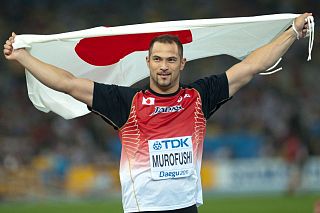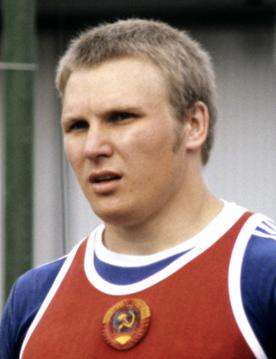
The men's hammer throw competition at the 2004 Summer Olympics in Athens was held at the Olympic Stadium on 20–22 August. There were 35 competitors from 24 nations. After a series of doping-related disqualifications, the event was won by Koji Murofushi of Japan, the nation's first medal in the event. All distances are given in metres.

Belarus competed at the 2004 Summer Olympics in Athens, Greece, from 13 to 29 August 2004. This was the nation's fifth appearance at the Summer Olympics in the post-Soviet era. The Belarus Olympic Committee sent a total of 151 athletes to the Games, 82 men and 69 women, to compete in 22 sports.

The Unified Team at the 1992 Summer Olympics in Barcelona, Spain, was a joint team consisting of twelve of the fifteen former Soviet republics that chose to compete together; the states of Estonia, Latvia, and Lithuania competed separately. The team has been informally called the Commonwealth of Independent States team, though Georgia was not yet a member of the CIS when it competed as part of the Unified Team. Selected athletes from the Baltic states also competed on the Unified Team. It competed under the IOC country code EUN. A total of 475 competitors, 310 men and 165 women, took part in 234 events in 27 sports.
Andrey Hakimovich Abduvaliyev is a former Soviet, Tajikistani, and Uzbekistani hammer thrower.

Sergey Nikolaevich Litvinov was a Russian hammer thrower and athletics coach. He competed at the 1980 Summer Olympics and the 1988 Summer Olympics, missing the 1984 Summer Olympics due to the Soviet boycott, and won a silver and a gold medal, respectively. He also won two world titles, in 1983 and 1987. After retiring from competitions he coached elite hammer throwers including Ivan Tsikhan and his son Sergey.

The men's hammer throw was one of four men's throwing events on the Athletics at the 1964 Summer Olympics program in Tokyo. It was held on 17 October and 18 October 1964, with the qualification on the first day and the final the next. 25 athletes from 14 nations entered, with 1 not starting in the qualification round. The maximum number of athletes per nation had been set at 3 since the 1930 Olympic Congress. The event was won by Romuald Klim of the Soviet Union, the nation's second consecutive victory in the men's hammer throw. Gyula Zsivótzky of Hungary repeated as silver medalist, the fifth man to win multiple medals in the event. Uwe Beyer took bronze, the first medal for the United Team of Germany and the first medal for any German hammer thrower since 1952.
Igor Yuriyevich Nikulin was a hammer thrower who represented the USSR, the Unified Team, and later Russia. He won the bronze medal at the 1992 Olympic Games in Barcelona, Spain.

The men's hammer throw was an event at the 1996 Summer Olympics in Atlanta, Georgia. There were 37 competitors from 22 nations, with twelve athletes reaching the final. The maximum number of athletes per nation had been set at 3 since the 1930 Olympic Congress. The eight highest-ranked competitors after three rounds qualified for the final three throws to decide the medals. The qualification mark was set at 76.50 metres. The event was won by Balázs Kiss of Hungary, the nation's first victory in the men's hammer throw since 1968 and fourth overall. Lance Deal earned the United States' first medal in the event since 1956 with his silver. Oleksandr Krykun's bronze gave Ukraine a medal in its debut as an independent nation.
The final of the men's discus throw event at the 1992 Summer Olympics in Barcelona, Spain was held on August 5, 1992. There were 32 participating athletes from 24 nations. The maximum number of athletes per nation had been set at 3 since the 1930 Olympic Congress. The top 12 and ties, and all those reaching 63.00 metres advanced to the final. The event was won by Romas Ubartas of Lithuania, a victory for the nation in its debut appearance in the men's discus throw. Jürgen Schult took silver, the first medal for unified Germany. Roberto Moya earned Cuba's first men's discus throw medal since 1980 with his bronze. Ubartas and Schult became the 11th and 12th men to win multiple discus throw medals; they had both represented different nations (the Soviet Union and East Germany, respectively, in 1988 and had finished one-two then as well, though in the opposite order.
The men's shot put was an event at the 1992 Summer Olympics in Barcelona, Spain. There were 26 participating athletes from 18 nations. The maximum number of athletes per nation had been set at 3 since the 1930 Olympic Congress. The event took place on 31 July 1992. The event was won by Mike Stulce of the United States, the nation's first victory in the men's shot put since 1968. His countryman Jim Doehring took silver. Vyacheslav Lykho of the Unified Team earned bronze, the first medal for a Soviet or former Soviet athlete in the event since 1980.

The Men's Pole Vault was an event at the 1992 Summer Olympics in Barcelona, Spain. There were a total number of 34 participating athletes from 23 nations. The maximum number of athletes per nation had been set at 3 since the 1930 Olympic Congress. The qualification mark was set at 5.60 metres.

The men's hammer throw at the 1988 Summer Olympics in Seoul, South Korea had an entry list of 30 competitors from 16 nations, with two qualifying groups before the final (12) took place on Monday September 26, 1988. The maximum number of athletes per nation had been set at 3 since the 1930 Olympic Congress. In the final round the eight highest-ranked competitors after three rounds qualified for the final three throws to decide the medals. The event was won by Sergey Litvinov of the Soviet Union, the nation's sixth victory in the event. The Soviet team completed the medal sweep, with Yuriy Sedykh taking silver and Jüri Tamm bronze. It was the Soviets' third medal sweep in four Games, with only the boycotted 1984 Games missing. The 1988 team was the same as the 1980 squad, with Litvinov and Sedykh trading places. Litvinov and Tamm were the ninth and tenth men to earn multiple medals in the hammer throw, while Sedykh became the fourth to win three medals; his two golds and a silver trailed only John Flanagan's three gold medals in Olympic success.
The men's triple jump event at the 1988 Summer Olympics in Seoul, South Korea had an entry list of 45 competitors, with 43 athletes from 31 nations starting in two qualifying groups before the final (12) took place on Saturday September 24, 1988. The maximum number of athletes per nation had been set at 3 since the 1930 Olympic Congress. The event was won by Khristo Markov of Bulgaria, the nation's first medal and victory in the men's triple jump. Igor Lapshin and Aleksandr Kovalenko of the Soviet Union took silver and bronze in an event where the Soviets had reached the podium eight consecutive Games before the 1984 boycott.

Tajikistan first participated at the Olympic Games as an independent nation in 1996, and has sent athletes to compete in every Summer Olympic Games since then. The nation has also competed at the Winter Olympics since 2002. To date, Andrei Drygin is one of two people ever to have represented Tajikistan at the Winter Olympic Games, being his country's sole competitor in 2002, 2006, and 2010.

The men's hammer throw was an event at the 1984 Summer Olympics in Los Angeles, California. There were 23 participating athletes from 13 nations. The maximum number of athletes per nation had been set at 3 since the 1930 Olympic Congress. The eight highest-ranked competitors after three rounds qualified for the final three throws to decide the medals. The qualification mark was set at 72.00 metres.

The men's hammer throw event at the 1980 Summer Olympics in Moscow, Soviet Union had an entry list of 17 competitors from 13 nations, with one qualifying group before the final (12) took place on 31 July 1980. Top 12 and ties and all those reaching 72.00 metres advanced to the final. The maximum number of athletes per nation had been set at 3 since the 1930 Olympic Congress. The event was won by Yuriy Sedykh of the Soviet Union, repeating as Olympic champion. He was the eighth man to win multiple medals in the event and third to have at least two gold medals. Just as in 1976, Sedykh led the Soviet team to a medal sweep, with Sergey Litvinov taking silver and Jüri Tamm bronze. The gold medal was the Soviet Union's third consecutive and fifth overall in the men's hammer throw, second all-time to the United States's seven.

The men's hammer throw at the 2000 Summer Olympics as part of the athletics program was held at the ANZ Stadium on Saturday, 23 September and Sunday, 24 September. There were 44 competitors from 24 nations. The event was won by Szymon Ziółkowski of Poland, the nation's first victory in the event and first medal of any color in the men's hammer throw since 1960. Silver went to Nicola Vizzoni, the first medal winner in the event for Italy. Igor Astapkovich, who had won a silver medal on the Unified Team in 1992, took bronze for the first medal credited to Belarus in the event. Astapkovich was the 11th man to win multiple medals in the hammer throw.

The men's hammer throw competition at the 1976 Summer Olympics in Montreal, Quebec, Canada took place on 26–28 July. There were 20 competitors from 13 nations. The maximum number of athletes per nation had been set at 3 since the 1930 Olympic Congress. The event was won by Yuriy Sedykh of the Soviet Union, the nation's second consecutive and fourth overall victory in the men's hammer throw. The Soviets swept the medals, with Aleksey Spiridonov taking silver and defending champion Anatoliy Bondarchuk earning bronze. It was the third medal sweep in the men's hammer throw. Bondarchuk was the seventh man to win multiple medals in the event.

The men's hammer throw was a competition at the 2016 Summer Olympics in Rio de Janeiro, Brazil. The event was held at the Estádio Olímpico João Havelange between 17–19 August. There were 32 competitors from 24 nations. The event was won by Dilshod Nazarov of Tajikistan, the nation's first medal in the men's hammer throw and first gold medal in any Olympic event. Ivan Tsikhan of Belarus took silver, the 14th man to win multiple medals in the event in adding to his 2008 bronze. Bronze went to Wojciech Nowicki of Poland, the nation's first medal in the event since 2000.

The 1992 CIS Athletics Championships was an international outdoor track and field competition for athletes from countries within the Commonwealth of Independent States. It was held on 22–24 June at Lokomotiv Stadium in Moscow, Russia. A total of 37 events were contested over three days.














